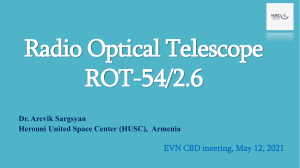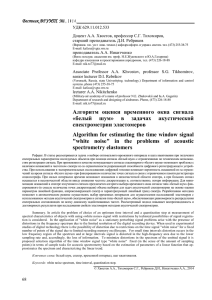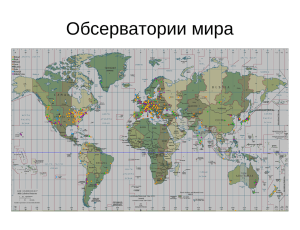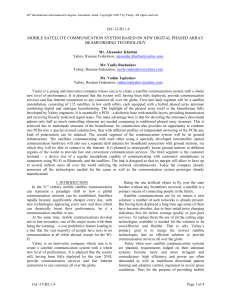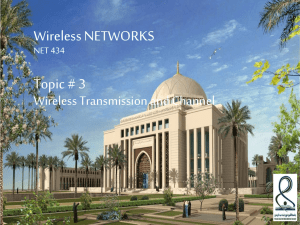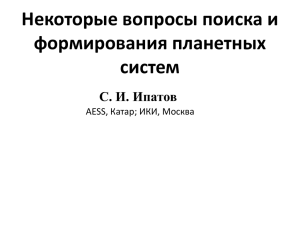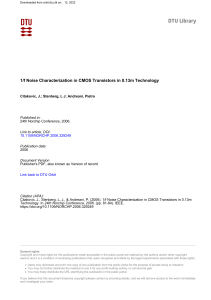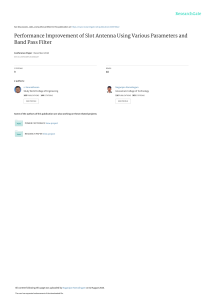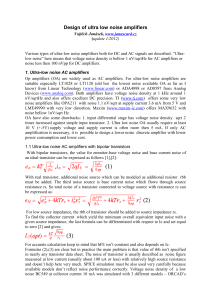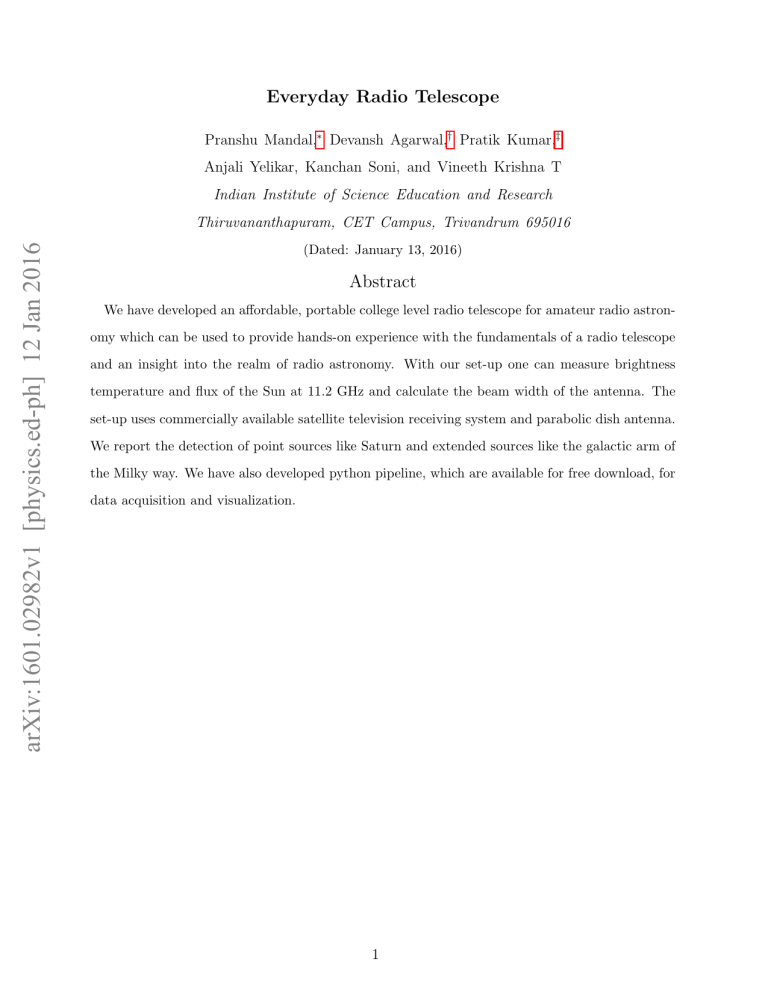
Everyday Radio Telescope Pranshu Mandal,∗ Devansh Agarwal,† Pratik Kumar,‡ Anjali Yelikar, Kanchan Soni, and Vineeth Krishna T Indian Institute of Science Education and Research arXiv:1601.02982v1 [physics.ed-ph] 12 Jan 2016 Thiruvananthapuram, CET Campus, Trivandrum 695016 (Dated: January 13, 2016) Abstract We have developed an affordable, portable college level radio telescope for amateur radio astronomy which can be used to provide hands-on experience with the fundamentals of a radio telescope and an insight into the realm of radio astronomy. With our set-up one can measure brightness temperature and flux of the Sun at 11.2 GHz and calculate the beam width of the antenna. The set-up uses commercially available satellite television receiving system and parabolic dish antenna. We report the detection of point sources like Saturn and extended sources like the galactic arm of the Milky way. We have also developed python pipeline, which are available for free download, for data acquisition and visualization. 1 I. INTRODUCTION Radio waves from astronomical sources have low intensities, and due to their long wavelengths, large radio telescopes are needed to gather signal and achieve resolutions comparable to optical telescopes. Building large telescopes is mechanically and economically challenging. Several schools, colleges and community astronomy clubs have optical telescopes, however, radio telescopes are not as famous due to their cost, the size and complexity of the data. We have developed a small, affordable radio telescope and data analysis tools to do amateur radio astronomy at such levels. For demonstrating the usefulness of such a set-up, we have measured the brightness temperature of the sun. We present how this can be used to measure the flux density of the sun and correlate them with presently available data. Modifications in the observation techniques, which improved the sensitivity and enabled us to detect point sources such as Saturn and extended sources such as the galactic arm, is also discussed here. II. AIMS AND SET-UP The prime motivation behind this project was to assemble and operationalize a low-cost radio telescope for amateur radio astronomy, study the properties of the telescope components and finally establish an undergraduate level experiment in radio astronomy. One that teaches the rudiments of this very well established technology by providing the necessary experiments. The setup has been proposed and assembled previously from NCRA(ASRT)1 , MIT(VSRT)2 , NRAO(IBT)3 , which was initially motivated by the works of Cleary et. al(1993)4 . This provided the groundwork to build on. A block diagram of our assembled setup is shown in Figure 1. The key components of the set up are: 1. Satellite Antenna: Satellite dish antenna consisting of a 68 cm parabolic dish reflector and an LNB (Low Noise Block). The LNB receives the radio signal from the satellite reflected by the dish and amplifies it. A set-top box powers the satellite finder and the LNB. 2 FIG. 1. Block diagram of the setup. 2. Satellite Finder: A satellite signal meter is commonly used for orienting satellite dishes towards geostationary satellites. We have used a commercially available analog satellite finder (GC SF-02). Such a device acts as a square law detector and is used to read directly the intensity. 3. Arduino Uno: Arduino is a microcontroller board with a 10 bit Analog to Digital Converter for us. Using this board, we digitize the intensity from the satellite finder at 10Hz sampling rate. The python pipeline for data acquisition and visualization can be found online.5 III. ANALYSIS Geostationary satellites emit polarized radiation, after pointing in the direction of satellites, the LNB was rotated to align the monopole inside in the direction of polarized radiation maximizing the detected signal intensity. Pointing was done manually in all the cases, by firstly looking at the source Altitude and Azimuth in the local sky at that time, using Stellarium and then rotating the dish about the two axes individually to point at the source location. The telescope was calibrated with geostationary satellites and power per unit voltage was calculated. For the temperature calculation, power density was calculated given aperture efficiency followed by the flux calculation. By assuming the sun’s radiation to be thermal, the temperature was calculated following Rayleigh-Jeans law.6 See section A for 3 detailed calculations. For beam-width calculation, the voltage data (in dBV) was fitted with a Gaussian (f (t) = ae− (t−b)2 2c2 ) using python and Full Width at Half Maxima (FWHM) was calculated √ using the variance (FWHM = 2 2 ln 2 c). Table I provides the obtained values. Figure 4, shows the drift scan of the sun. A Gaussian was fit to the data and beam width of our telescope was characterized to be ∼ 3.5◦ with less than 1% error. These are in agreement with standard online beam width calculators7 which estimate beam width of our system to be ∼ 3.4◦ . For the noise analysis, the dish was pointed at the cold sky. By cold sky, Epoch(MJD) Beam width(degree) 57111 3.357 ± 0.021 57108 3.501 ± 0.007 TABLE I. Beam width calculated from graphs we refer to the continuous radiation coming from the sky in absence of a source in the field of view of the telescope. This signal is predominantly due to the presence of Cosmic Microwave Background. A Fourier fit was performed, and residuals were termed as noise and taken forward for FFT in MATLAB. To evaluate the system generated noise, the LNB was shielded with thick aluminium foils to block any external radiation from reaching the system, and the same procedure was repeated. The noise in the signal (from the cold sky) is dominated by the system generated noise. The features in the FFT spectra (like a bump near ∼ 0.5 Hz) of system generated noise gets carried forward in the FFT spectra of the cold sky. The FFT spectra also revealed a difference in the power levels of the signal and the system generated noise. The signal had a higher noise power, which was likely to be observed. A difference in power levels of FFT spectrum for various days during day and night time was also noticed. This difference could be ascribed to temperature variations during the period of observation. Figure 2 and Figure 3 show the FFT spectrum during night and day time respectively. 4 −3 10 −4 10 −5 V(f) 10 −6 10 57309 57310 57302 system −7 10 −8 10 −3 −2 10 10 −1 10 Frequency(Hz) 0 10 1 10 FIG. 2. FFT of the daytime data. Different colour shows different epochs −3 10 −4 10 −5 V(f) 10 −6 10 57309 57310 57302 system −7 10 −8 10 −3 10 −2 10 −1 10 Frequency(Hz) 0 10 1 10 FIG. 3. FFT of the night data. Different colour shows different epochs IV. A. RESULTS Solar Brightness Temperature The flux received from the Sun was calibrated against the standardized data from various geostationary satellites, NSS 6, SES 7 and INSAT 4A. The flux received from these satellites and their corresponding voltages used in the calculation are shown in Table II and Table III. The brightness temperature of the sun was calculated to near 10,000 K with a maximum 5 error of 3.23 %, which is slightly lower than the values reported by Zirin et. al (1991)8 . Details of calculation are given in appendix A. Name Of Geo-Sat Altitude (Km) EIRP (dBW) NSS6 36237 50 SES7 36934 53 INSAT 4A 35916 52 TABLE II. Table of a few Geostationary satellites and their corresponding Equivalent isotropically radiated power (EIRP) used for calibrating the setup −0.32 Drift Scan Gaussian Fit −0.33 Voltage (dBV) −0.34 −0.35 −0.36 −0.37 −0.38 17:34:00 17:39:00 17:44:00 17:49:00 Time (IST) 17:54:00 17:59:00 18:04:00 FIG. 4. Drift scan of the Sun. Cyan dots is the data and black line is a Gaussian fit of the data. Epoch(MJD) ∆ Vsat(V) ∆ Vsun (V) σ Cold Sky(V) σ Sun(V) σ Sat(V) Temp(K) δ T(K) 57099 0.0980 0.0521 0.0009, 0.0009 0.0008 0.0016 10078 295 57115 0.0922 0.0493 0.0009, 0.0009 0.0011 0.0011 10136 324 TABLE III. Table of temperature calculated from same day calibration and scan data 6 B. Saturn and Milky Way Detection The radiometer equation gives us σT ∝ √ 1 τ ∆νRF (1) Where, σT is RMS receiver output fluctuation, ∆νRF is the bandwidth and τ is the integration time.9 The equation tells the reduction in noise when integration time is increased thus giving us a higher sensitivity. We increased our integration time from 1 second to 60 seconds, and drift scans were taken and for Saturn and galactic arm (as shown in Fig. 5). We report the detection of Saturn with an signal to noise ratio (SNR) of 3. The sources were confirmed by correlating the time of arrival of the source signal in the field of view of our telescope with the predicted times by Stellarium based on our pointing.10 Fig.7 shows the approximate path traced by the field of view of the telescope during the drift scan observation with respect to Fig 5. 0.42 Voltage (dBV) 0.43 0.44 0.45 0.46 17:40:00 18:10:00 18:40:00 19:10:00 Time (IST) 19:40:00 20:10:00 20:40:00 FIG. 5. Drift scans Saturn and Milky way. The pink and the green region corresponds to Saturn and the Galactic arm respectively. 7 V. DISCUSSION This radio telescope requiring only everyday items that make it affordable and a versatile tool to demonstrate the working of a radio telescope. The methods and calculations shown here give an all-round hands-on experience about fundamentals of radio telescopes, computer programming and data analysis with an inherent amateur astronomy in it. This radio telescope shows good response when customizations are made, which provides an opportunity to study the properties of the telescope itself. It has a very good response to the signal from geostationary satellites, and the pointing towards such point sources are easier due to the large beam width. Sun, being a strong and easily detectable radio source, is easy to point at and study. Drift-scan for the sun was performed, and data was fitted with a Gaussian. This reveals an important property: the antenna beam width and provides a coherent idea about it. When backed up with satellite observation (preferably near the same time) the same drift-scan can be used to measure source flux and brightness temperature. The radiometer equation (equation 1), shows that the noise is inversely proportional to the square root of the bandwidth of the telescope and the integration time. Thus by increasing the integration time, we can reduce noise. Most popular ammature telescopes like VSRT use RTL-SDR, which has a bandwidth of ∼ 3 MHz11 , whereas, with the satellite finder we can utilize the full 1.1GHz bandwidth, thus giving us a higher sensitivity. Although most undergrad institutions have such amateur astronomy programs, but radio astronomy is not popular among them. As we have shown, increase in sensitivity would give one the opportunity to look at many other sources than just the Sun. All-sky visibility maps can be generated at a rudimentary level that would make one familiar with a bigger part of the radio sky. We measured the temperature of the LNB surroundings during observations. An increase in the voltage was observed with the rise in temperature. The voltage and the surrounding temperature plot increases linearly as shown in Figure 6. The correlation coefficient between these two was obtainted to be 0.98, confirming the linear dependence of voltage on the surrounding temperature change. 8 31.5 Correlation Coefficient : 0.987500262872 31.0 Temperature ( ◦ C) 30.5 30.0 29.5 29.0 28.5 28.0 27.5 27.0 0.220 0.225 0.230 0.235 Voltage (V) 0.240 0.245 FIG. 6. Correlation between surrounding temperature and voltage. ACKNOWLEDGMENTS This work is supported by School of Physics IISER-Thiruvananthapuram. The authors would like to thank Joy Mitra and N. Rathnasree for useful discussion and helpful comments on this work. We would also like to thank S. Shankarnarayanan and M. Thalakulam for their support. AY, KS, PK, and PM are supported by INSPIRE fellowship. DA thanks the Max Planck Partner Group Research Facility at IISER-Thiruvananthapuram. A part of the manuscript was written while being a Project Assistant at the MPPG on GWaves at IISER-Thiruvananthapuram. ∗ [email protected] † [email protected] ‡ [email protected] 1 Connections seen from <http://www.ncra.tifr.res.in/rpl/rpl-past-events/ winter-school-experiments/procedure-for-making-affordable-small-radio-telescope> 9 2 MIT’s Very Small Radio Telescope <http://www.haystack.mit.edu/edu/undergrad/VSRT/> 3 Building and Using an Itty Bitty Telescope <http://www.gb.nrao.edu/epo/ibt.shtml> 4 D. Cleary, “An Amateur Radio Telescope for Solar Observation”, JRASC 93, 40(1993). 5 Our pipeline can be freely accessed from <https://github.com/diodedb/ArduinoPlot.git> 6 Michael Stix, The Sun: An Introduction (Astronomy and Astrophysics Library), 2nd edition(Springer, 2012), pp. 11-12. 7 Antenna Beam Width Calculator <http://www.satsig.net/pointing/ antenna-beamwidth-calculator.htm> 8 H. Zirin, B. M. Baumert and G. J. Hurford, “The microwave brightness temperature spectrum of the quiet sun”, ApJ 370, 779-783(1991). 9 Essential Radio Astronomy Course, <http://www.cv.nrao.edu/course/astr534/ PDFnewfiles/Radiometers.pdf>. 10 Stellarium is a free open source planetarium software <http://www.stellarium.org/> 11 M. Higginson-Rollins and A.E. Rogers, “Development of a Low Cost Spectrometer for the Small Radio Telescope (SRT), Very Small Radio Telescope (VSRT), and Ozone spectrometer”, American Astronomic al Society Meeting Abstracts 223, 148.24(2014) 12 EIRP values are available at <http://www.dishpointer.com> Appendix A: Appendix : Temperature Calculation We provide the detailed temperature calculation here. The Friis transmission equation gives a relation between power received by antenna, Pr of gain Gr when an antenna of gain Gt is transmitting a power Pt . Pr = Gt Gr Pt λ 4πR 2 (A1) Here, λ is the observing wavelength and R is the distance between the transmitter and the receiver antenna. For our system λ = 2.72 × 10−2 m. Distance to the satellite and EIRP values in the region are freely available on various websites.12 2 λ Pr = Pt Gt Gr 4πR EIRP = Pt Gt (for satellite) 2 λ Pr = EIRP Gr 4πR 10 (A2) For INSAT-4A, EIRP = 52 dBW in Trivandrum, India and R = 3.62657 ×107 m. Gain for an antenna is defined as. Gr = ηA πd λ 2 (A3) where ηA is the aperture efficiency which is the ratio of the antenna’s effective aperture Ae to the antenna’s physical aperture area Ap : ηA = Ae Ap and“d” is the diameter of the dish. For our setup ηA = 0.55. Gr = 0.55 × π × 0.71 2.72 × 10−2 2 = 3698.63 (A4) 2 λ Pr = EIRP × Gr × 4πR 2 2.72 × 10−2 5.2 = 10 × 3698.63 4π × 3.62 × 107 = 2.0957 × 10−12 W (A5) For INSAT-4A While pointing at a source, we measure the increase in voltage with respect to cold sky. We now standardize the power received for a unit increase in voltage for a bandwidth of 400MHz as the satellite emits only for this bandwidth and assume this extrapolates linearly for whole 1.1 GHz bandwidth. Here ∆Vsat = Vsat − Vbground and ∆Vsun = Vsun − Vbground Pr ∆Vsat = 0.0980V 1V = ∆Vsat (A6) ⇒ 1V = 2.1384 × 10−11 W (A7) Power received from the sun is now calculated : ∆Vsun = 0.0521V ⇒ Pt = 11.1410 × 10−13 W (A8) Power density, Pd and flux calculations are as follows. Pt Gr λ2 = 0.2177m2 , and Pd = = 5.1175 × 10−12 W/m2 4π Ae 2 × Pd × 2.75 flux = = 2.5587 × 106 Jy ∆νRF where Ae = (A9) (A10) where ∆νRF =1.1 GHz We include a factor of 2 because we only observe one polarization. INSAT-4A emits in 400 MHz band while emission from the sun is broadband in nature emitting for whole 1.1GHz 11 bandwidth. Therefore, we include a factor of 2.75 for solar flux calculation. We assumed that the Sun’s radiation is thermal and used Rayleigh -Jeans law to calculate the temperature. The intensity, I I= F lux = 3.7599 × 1010 Jy/Sr Ω where Ω = 6.8052×10−5 Sr , is the solid angle subtended by the sun. and the temperature, T T = Iλ2 = 10078 K 2KB 12 FIG. 7. The red line show the approximate path traced by the field of view of the telescope during the observation shown in Figure 5. The coordinate of Saturn at the time of it’s passing is shown on top left corner. 13
